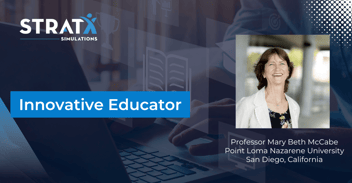Case Study: Transforming Marketing Education with Digital MediaPRO at UBC Sauder
By April Giarla
.png?width=1200&height=627&name=Innovative%20Educator%20-%20Blog%20Post%20(5).png)
When Ann Stone, a recently retired marketing instructor at UBC Sauder School of Business, integrated the Digital MediaPRO simulation into her Integrated Marketing Communications (IMC) courses, she aimed to transform how students understood and applied media strategy in marketing. Traditionally considered a dry topic, media planning was brought to life through Digital MediaPRO, giving students an engaging, hands-on experience that connected seamlessly with course objectives.
Course Design & Learning Objectives
Ann strategically embedded Digital MediaPRO into both her undergraduate and graduate IMC courses, ensuring that students didn’t just learn about marketing theory—they practiced it. Her learning goals were clear: strengthen students’ ability to develop a marketing brief, build decision-making skills in media planning, and connect those decisions back to the brief itself.
“The core of IMC is the development of a Brief, which directs the work of creative output as well as media, the selection of where that creative will be placed. By allowing students to see the results of their choices about media selection, Digital Media Pro serves as an essential part of the learning objectives of making media choices, and how do those choices link back to the Brief.”
Simulation Integration
Ann introduced the simulation after students had built a foundational understanding of the marketing brief. She structured the experience to maximize learning and engagement.
Undergraduate Course
Students prepared and submitted a Year 1 brief, which she evaluated before the simulation. They then ran Years 1-5 of the simulation during class time over multiple days, with Ann providing lectures, coaching, and personalized video feedback—especially after Year 3. “After year 3 I provide significant feedback via video to all teams with reinforcement of decisions well made or course correction recommendations,” she noted. The simulation concluded with a team paper that prompted reflection and learning.
Ann emphasized the importance of process over competition: “I emphasize throughout the course that the simulation is about learning, not winning. I do compare the teams, with the top team receiving and A+, but every student receives a mark at the target course average or above. More importantly, the development of their Starting Point Brief and After Sim Paper are weighted at 4 times great importance to their final grade than their performance mark.”
Graduate Course
Graduate students followed a similar path, running Years 1-3 independently over a weekend and then completing Years 4-5 in class, guided by Ann’s insights. Due to the challenges of coordinating group work, reflection papers were submitted individually. “The after sim paper is individual at the request of prior classes given the difficulty of students coordinating time to engage together on key learnings.”
Ann emphasized that feedback timing was crucial: “The after year 3 feedback is critical, as the course correction coaching can provide a significant boost for teams experiencing poor results.” Her proactive coaching ensured all teams could learn and adapt effectively.
Student Engagement & Outcomes
Students responded enthusiastically to the team-based approach. “They do their work in teams, which are almost universally seen as adding significant value to their learning and enjoyment of the course,” Ann observed. Working in teams fostered collaboration, accountability, and lively discussions—often cited by students as highlights of the course.
“My learning objectives are met; compared to textbook chapters and supplemental readings, student engagement with and understanding of media in today’s world is much stronger.” She added, “I have some quotes in my files of students articulating what they learned with wonderful precision; they reconfirm how important this learning tool can be.”
Assessment Details
Ann complemented the simulation with a carefully selected quiz from StratX’s question bank. “It is critical to make sure that each student is prepared to contribute to their team’s efforts. A individual quiz is important to check in on this readiness,” she shared. “The question bank allowed me to pull out what I felt was best to reinforce for my students and quickly upload and use them in Canvas.
Challenges and Lessons Learned
Ann’s journey wasn’t without challenges. Initially, she didn’t require students to submit a starting point brief—a mistake she quickly corrected. “It didn’t reinforce the core of the course, the Brief. I inserted into my Brief template information they could find in the sim, so they could see what information went into a Brief but also I could evaluate the conclusions they were drawing prior to running Year 1 of the simulation. ” This new approach created a need for rapid feedback on the Brief so that students could move into day 1/Year 1 of the simulation. “While it is tough to get their papers and turn them around in 48 hours, it gives teams the chance to rethink areas identified and see good ideas confirmed.”
Coordination was another challenge: “I started this out with the direction of ‘run the sim when you like’. Bad idea! Have them run it during regular class time; everyone is free then. Otherwise, teams fail or have students never engage because they can’t logistically work it out.”
Reflection & Evolution
Ann exemplified a growth mindset. “I evolve after every time I run the simulation,” she reflected. Her approach to continuous improvement—refining the simulation experience based on student feedback and her own observations—ensured that each cohort benefited from a more effective learning experience.
Advice for Other Educators
- Require some a starting point brief to align the simulation with core learning objectives.
- Run simulations during class time to promote engagement and teamwork.
- Emphasize learning over results; use grades to motivate, don’t allow performance to be a predominant measure.
Conclusion
Ann Stone’s integration of Digital MediaPRO into her IMC courses transformed her students’ learning experience. Through careful design, iterative refinement, and a commitment to student engagement, she turned a traditionally dry topic into an interactive, collaborative, and highly impactful learning journey.

-min.png?width=352&name=Blog%20Image%20Template%20UPDATED%20(11)-min.png)

-min.png?width=352&name=Blog%20Image%20Template%20UPDATED%20(13)-min.png)